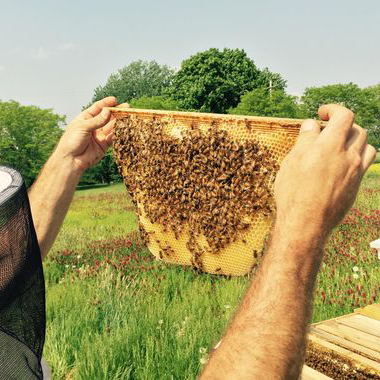How did you become interested in beekeeping? How did you get started?
‘Coach’ Mark Smallwood, our executive director, was beekeeping one afternoon last year in the apiary when he saw a swarm and needed help. I was riding past him on my bicycle and he called me over. Within a few short minutes, I was 30 feet up in a tree capturing my first swarm. I quickly became fascinated, then obsessed with honeybees. I’ve been hooked ever since.
What type of hive do you work with? What are the benefits/drawbacks to using that type of hive?
I work with top bar / Langstroth hybrid hives. The top bar arrangement mimics a hollow tree so that bees can make brood and honey as they would in nature. The Langstroth arrangement allows the beekeeper to take honey and work the hives easily. I leave the honey in the top bar section for the bees to eat over the winter.
One drawback to using in this hive is that because we don’t use foundation, sometimes we have problems with cross-combing and bulging. Cross-combing is when they build their comb across two or more top bars instead of straight along a single top bar. Bulging is when some of the comb bulges out, so the bees compensate on the next bar, and then the next, till all the comb is made in a semi-circle instead of vertical.
Do you feed your bees with anything? If so, what? Do you allow them to keep some of their honey?
I don’t feed our bees anything. Not even water. We have a pond less than 100 yards from the apiary.
At this stage in the development of the apiary, we allow the bees to keep all of their honey. The plan is to let a colony keep all their honey until they are very strong, which may take up to three years. Once the colony is strong and healthy, the plan is to keep the top bar section of the hive full of honey for the bees to keep, and then to add Langstroth boxes for the bees to fill with honey for harvest.
Where do your bees come from? Are all bees basically the same or are there many different bee varieties?
We bought packages of bees from Azure Bee in Maryland, from Stefano Briguglio who was mentored by ‘Coach’ Mark Smallwood, just like me. The packages included one queen and three pounds of bees. They are untreated Italian Honeybees.
There are over 20,000 species of bees, and 7 recognized species of honeybee, and 44 subspecies of honeybee. There are hybrids and different genetic variations.
What’s the most fulfilling part of a beekeeper’s job?
I feel a deep personal connection with something very different from me, and yet not so different. Sometimes when I get home, I can still hear them buzzing. A healthy colony is truly a super-organism. There are maybe 50,000 bees in a healthy colony, but they are one. They work so hard individually, but everything they do is for the colony. I love the smell on my hands after I’ve worked the hives. I love planting flowers for them. I love just watching them. I know when I see flowers bloom on the farm, or when the plants go to seed, that I was a part of that. Beekeeping is about so much more than honey.
Follow our campaign to change Honey Month to July with The Rodale Institute or here on our partnership page.














